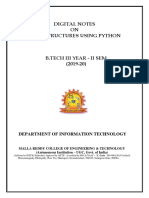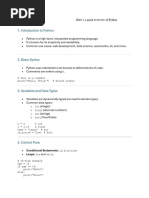0 ratings0% found this document useful (0 votes)
10 viewsPython Notes
Python is an interpreted, high-level programming language known for its readability and versatility in various fields like web development and data analysis. It employs indentation for code blocks, supports multiple programming paradigms, and includes control flow structures such as conditionals and loops. Key libraries include Numpy for numerical computations, Pandas for data manipulation, Matplotlib for visualizations, and Flask/Django for web development.
Uploaded by
MohdCopyright
© © All Rights Reserved
We take content rights seriously. If you suspect this is your content, claim it here.
Available Formats
Download as PDF, TXT or read online on Scribd
0 ratings0% found this document useful (0 votes)
10 viewsPython Notes
Python is an interpreted, high-level programming language known for its readability and versatility in various fields like web development and data analysis. It employs indentation for code blocks, supports multiple programming paradigms, and includes control flow structures such as conditionals and loops. Key libraries include Numpy for numerical computations, Pandas for data manipulation, Matplotlib for visualizations, and Flask/Django for web development.
Uploaded by
MohdCopyright
© © All Rights Reserved
We take content rights seriously. If you suspect this is your content, claim it here.
Available Formats
Download as PDF, TXT or read online on Scribd
You are on page 1/ 1
Python (Notes)
1. Introduction to Python:
• Python is an interpreted, high-level programming language known for its easy-to-read
syntax.
• Widely used for web development, data analysis, artificial intelligence, automation, and
scientific computing.
2. Python Basics:
• Python uses indentation to define code blocks instead of curly braces {}.
• It supports multiple programming paradigms, including object-oriented, imperative, and
functional programming.
3. Control Flow:
• Conditionals: Python uses if, elif, and else for decision-making.
if x > 5:
print("x is greater than 5")
• Loops: Python has for and while loops.
for i in range(5):
print(i)
4. Functions:
• Functions are defined with def and can accept parameters.
• They can return values using return.
def greet(name):
return f"Hello, {name}!"
5. Python Libraries:
• Numpy: Used for numerical computations and working with arrays.
• Pandas: Used for data manipulation and analysis.
• Matplotlib: For plotting data and creating visualizations.
• Flask/Django: Web frameworks for building dynamic web applications.
You might also like
- Program Name: B.Tech Semester:6TH Course Name: Course Code: Facilitator Name:ANTIM PANGHALNo ratings yetProgram Name: B.Tech Semester:6TH Course Name: Course Code: Facilitator Name:ANTIM PANGHAL13 pages
- FYCYS 301 Debolina Chakraborty 31140423013No ratings yetFYCYS 301 Debolina Chakraborty 311404230139 pages
- I PUC CS Chapter 5 Getting Started With Python FinalNo ratings yetI PUC CS Chapter 5 Getting Started With Python Final30 pages
- Python_Fundamentals_Presentation nverseenNo ratings yetPython_Fundamentals_Presentation nverseen11 pages
- Mastering Python: A Comprehensive Guide for Beginners and ExpertsFrom EverandMastering Python: A Comprehensive Guide for Beginners and ExpertsNo ratings yet



























































